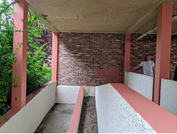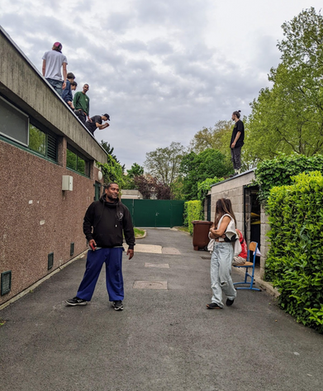Visiting the Birthplace of Parkour
- Maayan Olshan
- May 21, 2024
- 6 min read
By Coach Amy
Have you ever wondered what the Freedom In Motion foot logo is all about? Well, if you
look closely you’ll see what seems to be a random assortment of dots and lines and shapes. But in fact they are not random! The design is based off of a real life Parkour structure called the Dame du Lac located in Evry, France, which is also known as the birthplace of parkour. The sculpture was built in 1975 by architect Pierre Székely and was originally created for alpinists. Meant to resemble a rock cliff, the sculpture stands at 17.5 meters high (~60ft) with a central chimney, multiple ledges and an array of hand holds which seem to lead to everywhere and nowhere all at the same time. It is truly a climbers playground!
While in Evry, I had the wonderful privilege of getting a parkour history tour led by Yann
Hnautra who is one of the founding members of the Yamakasi parkour team. The tour began at the Dame du Lac which stands at the edge of a lake in a beautiful park. Yann opened by giving a brief history of the Yamakasi team. Though many were most likely doing some form of parkour on their own, they were some of the first practicing parkour athletes to establish themselves as a parkour team. It’s important to note that in France they called themselves ‘traceures’ originating from the French word ‘tracer’ which means to move very quickly. Not only was the physical aspect of parkour valuable to them, but the philosophy behind their movement as well.
This perspective was immediately established in their name ‘Yamakasi’. He explained that this name comes from the Lingala word for, “Strong Man, Strong Spirit”. The group’s philosophy is to become a strong individual physically, mentally, and ethically. With this spirit, the group set out to spread parkour from their hometown to the rest of France and the world. And nowadays if you ask any long time practitioner of parkour about the Yamakasi, they will very likely smile and say that the Yamakasi were one of their first inspirations to start training parkour.
Another reason the Yamakasi are so groundbreaking is because they developed so
many of the moves that are foundational to parkour. Following the Dame du Lac we walked to a nearby neighborhood and got to see several infamous parkour spots where many of these moves were created. One spot was called ‘Red Walls’ where the Kong Vault came into being (see photo 1+2). Another spot right around the corner was where the Cat 180 was debuted (see photo 3). Further down near a public pool and a pub were several iconic roof gaps spots (see photo 4+5). Most parkour historians will have seen the film Speed Air Man, which shows David Belle, one of the original members, doing a lot of these renowned first parkour moves at these locations.
They even created a mural in his honor on one of the adjacent buildings (photo 6).Yann specifically shared how the techniques of certain moves have evolved over the years. For example they used to perform the Cat Leap by jumping to a wall but onto their forearms and elbows. Now the move has evolved to be more efficient where people jump to their hands and feet (since they usually wear parkour shoes) and finish in a more comfortable hang before climbing up onto a wall. He’s happy for things to have evolved like that because it pushes the sport forward and hones the practice in to be more sustainable as well.
After exploring and jumping around at these historically celebrated spots we gathered
back together to end the tour back at the Dame du Lac. It was obvious to see that parkour as a sport is honored and revered in the city of Evry. The positivity and impact it’s brought to the community is unparalleled. Even the mayor rode by on his bike and casually greeted the Yamakasi members like they were old friends. That’s the level of respect they have.
After taking a group photo and saying our goodbyes I assumed that would be the end of
our adventure. But after most people had departed and a few of us were still mingling, Williams Belle had one last mission for the evening. He said “I need to climb!”. After talking about parkour for several hours he just wanted to move and play. So we looked over at the Dame and the few of us remaining decided to join in on the fun. We warmed up a little by jumping and climbing on a few of the lower ledges before Williams suggested we try to climb to the top of the structure. I was not planning on that challenge and honestly felt very mentally unprepared. However, Williams shared that the first time he ever climbed the Dame du Lac was when he was twelve years old with the help of a coach! Ever since then he’s been helping people overcome their fears while experiencing the challenge and feeling of getting to the top. But it is not just about
overcoming the mental battle, it’s very technical and very risky. Many have fallen and gotten hurt or even died climbing this structure. Knowing all these things he talked about the process of getting up and how the team would be there every step of the way, but the decision was ultimately up to us. For me, it felt more like a mental challenge than a physical one because of the extreme height and narrowness of the ledge. Let’s just say holding onto 8 inches of concrete at 60 feet is not your average Monday evening activity! I also know how many people have tried and failed to ascend this behemoth of concrete. Would I be among the many where fear won? Was I even capable physically? Why am I even trying this? Is it worth the risk? Even if I made it up, coming down seems worse! These were the thoughts I had to consider but sooner or later would have to shut out if I was to take on this challenge.
My two friends that I was with decided to go for it, and after watching them both safely
succeed I finally decided to as well! From the very start of the ascension Williams was above narrating every step and handhold I should take on the ledge while Mehdi (another member) was right below me encouraging me and making me feel safe. All I had to do was stay calm and trust my hand and foot placement. My mind was focused, ‘Follow the golden rule of three points of contact, only move up when you feel secure in your holds right here, move your foot then hand, foot then hand.’ And before I knew it I was at the overhang, the most difficult part of the climb at the very end. I secured my hands and got my chest over the ledge and pulled the rest of my body over. The feeling of cresting over that ledge was a feeling of relief mixed with joy! A beautiful view of the sunset was awaiting me at the top along with my troupe of friends who helped me get there. We took in the colorful views of Evry and in the distance you could just make out the Eiffel tower on the horizon. Someone joked around about sleeping at the top so we didn’t have to climb back down that night. But before it got too dark we descended in the same way we ascended with support the whole way through.
So, does it take a village to climb the Dame du Lac? Maybe not for everybody. But I
think the way I did it highlighted what parkour means to me and through others I was able to achieve something I never even envisioned for myself.
Now, you might be wondering if I answered my own questions of ‘Why am I even trying
this?’ and ‘Is it worth the risk?’. And to that I would say yes, absolutely. And why? Well because it’s very much in line with the spirit of parkour and a part of what it means to be human. To quote the sculptor Pierre Székely when speaking about the design of the Dame du Lac, “...it seems to me to express visually the challenge accepted by humans to strive to attain the limits
of the possible.”
A Sculpture in Concrete for Practicing Alpinism
An article about the Dame ^














Comentários